1943: Situation Normal: All Fouled Up
Another year, more cartoons! In what's probably one of the most controversial years of the Looney Tunes and Merrie Melodies, we get even more war-themed shorts, and something all new from the Schlesinger studio!
Coal Black and de Sebben Dwarfs
Directed by Robert Clampett
Part of the Censored 11, withdrawn from TV distribution in the 60s. A mother tells her child a story parodying Snow White. The mean old queen asks her magic mirror to send her a prince – but Prince Chawmin' is interested in the attractive So White instead. The angry queen tries to have her taken out, and a poisoned apple does its job. Will the prince's kiss revive So White? From what I've seen of the Censored 11, most of them are rather average (or sometimes below average) in quality – I doubt there would be much interest in them without all the controversy. And then there's "Coal Black", a fixture on lists of greatest cartoons. Fairytale parodies have always been one of the WB crew's fortes, and here that's combined with Clampett's wild, fast-paced style. The animation is amazing, there's a great jazzy soundtrack, many funny lines... The cartoon was arguably even ahead of its time in some regards – while it wasn't the first WB cartoon with a black cast of characters, in this case most of the voices were also performed by black actors (Vivian Dandridge being especially brilliant as the lead character). Sadly, it's not free from the stereotypes of the time: some of the character designs are quite unfortunate, and a couple of (thankfully brief) gags would have been better left out. But despite these flaws, Clampett always claimed good intentions behind making this cartoon, and that's probably a big reason why it manages to be such a great cartoon despite some undeniably offensive material.
10
Confusions of a Nutzy Spy
Directed by Norman McCabe
Constable Porky and his constantly sneezing bloodhound companion Eggbert search for the Nazi saboteur Missing Lynx. The sly lynx tries his best to outwit the duo who have to stop him from blowing up a train. Some parts of this cartoon remind me slightly of the 1936 classic "The Blow Out", both of them involving Porky (albeit in very different roles) and a mad bomber. While this might not stand out among its contemporaries as much as that short did, it's a fun and fast-paced cartoon with an amusing cast of characters and some rather surprising gags.
9.5
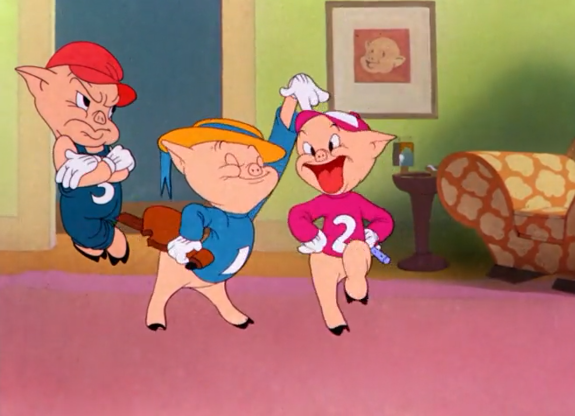
Pigs in a Polka
Directed by I. Freleng
The story of the Big Bad Wolf and the Three Little Pigs (the wolf himself hosting and naturally emphasizing the former) is told to the tune of Brahms' Hungarian Dances. The cartoon action is timed to the music – Freleng had done this before in 1941's "Rhapsody in Rivets", but I find this cartoon even better, as the characters and gags are funnier. The result is a masterpiece, and much of it is thanks to Freleng's impeccable timing. While it's a very nostalgic film for me (it may in fact have been one of the very first cartoons I ever saw!), that aspect is something I find myself admiring a lot more now. The short got some accolades at the time – the studio got an Oscar nomination (for some reason for the year 1942) for it, but lost to Disney's topical Donald Duck short "Der Fuehrer's Face" – not an injustice at the level of "A Wild Hare" being beaten by "The Milky Way", but I'd definitely have gone for this one myself. And speaking of Disney, as much of an animation milestone as their 1933 version of "Three Little Pigs" is, "Pigs in a Polka" is the definitive version in my book.
10
Tortoise Wins by a Hare
Directed by Robert Clampett
After watching a newsreel of Cecil Turtle beating him in their race, Bugs challenges him to another one. Wanting to learn Cecil's secret to winning, Bugs (in an unconvincing disguise) is told by him that the streamlined design of the turtle is the reason the rabbit always loses. Bugs uses a self-made turtle shell and swimming cap to what should be great success, but a group of gangster rabbits has decided to make the turtle lose at all costs... "Tortoise Beats Hare" was one of the biggest highlights in the early Bugs Bunny cartoons, and for a sequel, Clampett was the perfect successor to Avery, being the closest in style of all the remaining directors. The personalities and character chemistry from the original remain, though the approach is different at times – instead of blatant cheating, the two racers mostly use their wits, and outside forces affect the outcome of the race. Definitely a worthy follow-up!
10
To Duck... or Not to Duck
Directed by Charles M. Jones
After Elmer (accompanied by his trusty dog Laramore) manages to shoot Daffy down from the sky, the duck accuses him of poor sportsmanship and challenges him to a real one-on-one fight. The two have a boxing match, but Daffy and a fellow duck as the referee don't really play by all the rules... The first cartoon to star both Daffy and Elmer, a duo that would be featured quite a few times later in the series. And it's a very entertaining one with several funny gags, and both of the main characters (as well as the co-stars) being great in their roles, especially Daffy. Out of the boxing-themed cartoons, which we've already seen a few of (if this even counts as one, as it isn't played straight at all), this is among the best.
9.5
The Fifth-Column Mouse
Directed by I. Freleng
Mice have fun in the kitchen until the cat shows up. However, the cat convinces a gray mouse that he won't hurt the mice if they sign a truce. The mouse manages to get all the brown mice on his side, but can the cat be trusted? This is an unusually musical cartoon for 1943, as the mice are heard singing multiple songs (including WB cartoon classics "Ain't We Got Fun", "Blues in the Night" and "We Did It Before"). Typically for the time, the film isn't just a story about a cat and mice, but a WWII allegory (with some really obvious wartime references), showing how appeasement can go wrong. At the same time, it manages to be an entertaining cartoon. While the song sequences would sometimes drag down earlier WB cartoons (especially when they had to be placed in almost every cartoon), I really like the ones in this cartoon, especially the "We Did It Before" sequence with the mice marching along. Another good entry in what has so far been an amazing year for WB cartoons!
9
Flop Goes the Weasel
Directed by Charles M. Jones
A mother hen's egg is about to hatch, so she goes out to get a worm for the chick. But while she's gone, a weasel snatches the egg. It soon hatches, and the chick thinks the weasel is his mother. The weasel tries to eat him, but the extremely talkative chick ends up giving him a lot of trouble when they play hide and seek and other games. The characters are pretty obvious black stereotypes (in bird form), though thankfully more tasteful than in the earlier "The Early Worm Gets the Bird". The story seems fairly derivative of Avery's "The Sneezing Weasel" (sneezing included), but it's a decently entertaining though rather average short.
8
Hop and Go
Directed by Norman McCabe
Kangaroo Claude Hopper claims he's the best hopper in the whole world. Two Scottish rabbits see him and decide to take him down a peg. They proceed to make a fool of him in various ways. While by no means an all-time classic, the short is a fun one. The lead character is a likable one in his charming goofiness, and the rabbits are a good foil for him. The ending dates this cartoon a bit (almost every cartoon this year has at least some war references).
8.5
Super-Rabbit
Directed by Charles M. Jones
In this Superman parody, we hear the story of how Bugs became the Rabbit of Tomorrow after a scientist gave him a super carrot. He flies to Deepinaharta, Texas to stop Cottontail Smith, a rabbit hater who's planning to shoot all the rabbits. While Superman was parodied multiple times in the WB cartoons, sometimes even more funnily, this first full short dedicated to the theme is already a good one. The most significant aspects of the original are spoofed here, including Clark Kent as a "mild-mannered forest creature". Cottontail Smith isn't as funny as some of the other parodic villains in the WB cartoons, though he fares decently in his role. There are some classic moments, though, especially Bugs leading the villain and his horse in a cheerleading chant. The ending is a surprising one, but fitting for the time.
9
The Unbearable Bear
Directed by Charles M. Jones
A burglar fox breaks into a bear couple's house. He meets Sniffles, managing to convince the extremely talkative mouse that he's Robin Hood, stealing from the rich to give to the poor. The mouse's noisiness proves a big challenge to his attempts. Things get even messier when the policeman bear comes home, trying to stop the burglar, but also not wanting his wife to wake up and find out he's been drinking again. This film really emphasizes how much Jones' cartoons have changed in style. This is much more comedic than the cutesy earlier Sniffles shorts. The character himself has also changed a lot, becoming even more talkative than before (resembling his former co-star Batty in this regard) and unknowingly annoying the other characters with this. This new version of the character is much funnier than the previous one, and the rest of the cartoon is also great with all the wacky events, gags and characters. The adorable (or adorably annoying?) mouse's best appearance to date!
9.5
The Wise Quacking Duck
Directed by Robert Clampett
Mr. Meek has to roast a duck for his wife, and Daffy's the unlucky one. He keeps outwitting and annoying the guy over and over with his usual wackiness. The craziest portrayal of Daffy we've seen in a while (and that's saying a lot!) – we see many wild scenes with him, including a very memorable one with him undressing. The humor in this short is indeed pretty risqué in a couple of parts. The only flaw I found here is the ending, which I think is a bit sudden and underwhelming.
9.5
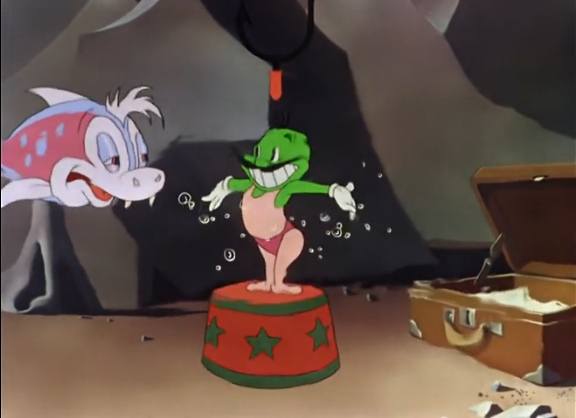
Greetings Bait
Directed by I. Freleng
The Wacky Worm makes his second appearance, with a fisherman using him as bait. The worm lures various fish until meeting a crab that ends up chasing him. Nominated for an Oscar, but the Tom and Jerry cartoon "The Yankee Doodle Mouse" took the award. I find the nomination a bit surprising, as while this is an entertaining short (mainly thanks to the worm character), the studio released many even better cartoons this year. Still a worthy sendoff to a funny but short-lived character, with some interesting visuals (including a scene of the crab looking at the worm from two directions, from the crab's own point of view).
8.5
Tokio Jokio
Directed by Cpl. Norman McCabe
A narrator claims this is a public showing of a film captured from the Japanese, showing a propaganda newsreel. We see various gags about Japanese defense efforts, but also ones about fashion and sports, for example. In case this description didn't already make it clear, the cartoon that claims to present "a typical example of vicious Japanazi propaganda" is ironically a vicious propaganda film in itself! It's often considered one of the most offensive shorts in the entire series, and it's hard to disagree with this – unflattering stereotypical designs and voices are seen and heard throughout. While this is not really surprising in a wartime short, another big flaw is that very few of the gags are funny in any way (the last gag with a literal minesweeper is the most amusing one). The animation is well done as usual, but besides that, there's not much to praise here. A pitiful last directorial effort by the otherwise impressive McCabe, who was drafted and would work on army films after this – this was reflected in the credits listing his military rank. He would never direct another Warner Bros. cartoon, but returned to work on the Looney Tunes as an animator in the 60s, doing his last work for WB in the mid-90s!
4
Yankee Doodle Daffy
Directed by I. Freleng
Porky, president of Smeller Productions, is on his way to an important appointment when actors agent Daffy shows up, representing a kid duck called Sleepy Lagoon. He wants Porky to give the kid a chance, but Daffy being Daffy, he instead performs examples of the kid's repertoire himself to Porky's annoyance. A hilarious cartoon with Daffy being his lovably annoying self – another masterful combination of comedy and music by Freleng.
10
Jack-Wabbit and the Beanstalk
Directed by I. Freleng
Bugs has climbed the beanstalk to Giantland after hearing about the giant carrots there. However, a giant notices him cutting the carrots in his victory garden and is angry. After the two duel at Bugs' suggestion, the giant manages to trap Bugs. Can the bunny escape? This cartoon has several funny gags, with Bugs as likable as always, and despite his lack of intelligence, the giant's size makes him an unusually tough enemy for Bugs.
8.5
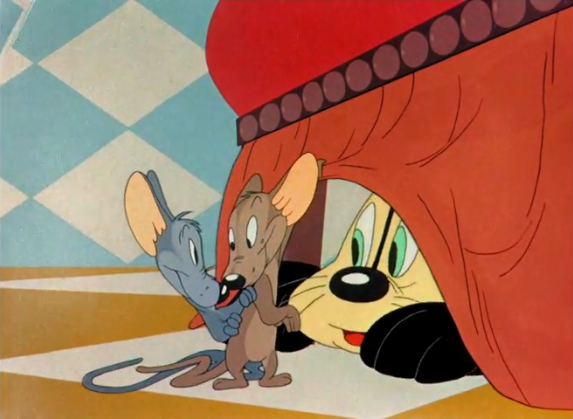
The Aristo-cat
Directed by Charles M. Jones
A pampered cat is left alone and starving when his servant Meadows decides he's had enough of his behavior and quits. He then has to consult a book about how cats usually behave and finds out that cats usually eat mice. But he's so sheltered that he doesn't even know what a mouse looks like, and two mice convince him the dog in the yard is a mouse! This is the first appearance of another new introduction by Jones: Hubie and Bertie. The two sly mice already have their later personalities and familiar quotes ("Hey Boit!", "Yeah yeah, sure sure"), though the still unnamed Hubie is colored brown and Bertie gray here (the colors would be switched later). While some of the later cartoons with the mice would be even better (and have a more interesting foil for them), this is a very good debut. And yet again, the stylized, abstract backgrounds (even stranger than in the last few Jones cartoons) caught my eye!
9
Wackiki Wabbit
Directed by Charles M. Jones
Two hungry castaways end up on a Hawaiian island. They find food there: Bugs Bunny! But their plans to have roast rabbit don't work out with Bugs playing tricks on them. Another enjoyable entry in the Bugs series. Bugs himself is brilliant once again, of course, and the two men (caricatures of and voiced by writers Tedd Pierce and Michael Maltese) are also entertaining characters. There's also a memorable gag involving subtitled Hawaiian and English speech with a nice fourth wall break.
9
Tin Pan Alley Cats
Directed by Bob Clampett
Another Censored 11 cartoon. A cat (a caricature of Fats Waller) is warned by a preacher for Uncle Tomcat's Mission not to go to the Kit Kat Klub where he'll be tempted by "wine, women and song". But this sounds good to the cat. During a jazz performance, he literally gets sent out of this world. In style, this is rather similar to "Coal Black and de Sebben Dwarfs" – a Clampett tribute to jazz music, although with some questionable stereotypes. The soundtrack (with some gospel music mixed in too) is amazing indeed, some scenes are appealingly surreal, and the animation is very wild. But in addition to the controversial aspects, there are a couple of parts of the cartoon that feel rather lazy. The Wackyland sequences from "Porky in Wackyland" are reused with few alterations besides being in color now, and the plot isn't completely new either (compare it with the earlier but inferior and more offensive "Goin' to Heaven on a Mule" and "Sunday Go to Meetin' Time"). Despite the strong parts of this cartoon, these flaws prevent what is an enjoyable film from being a great one.
8.5
Porky Pig's Feat
Directed by Frank Tashlin
Porky and Daffy have been staying in Broken Arms Hotel. They're not allowed to leave before they pay the bill, and Daffy's attempts to get the money by gambling go wrong. The duo try various wacky methods to leave, but the hotel manager keeps stopping them. This was Tashlin's first cartoon for the studio since 1938, as he replaced Norm McCabe in his directorial unit. And what a cartoon it is! Every single gag is hilarious, the characters (especially Daffy) are in top form, the animation is excellent... I'd say this is better than anything Tashlin did in his previous Schlesinger stint, and one of the very best cartoons the whole studio has made so far!
10
Scrap Happy Daffy
Directed by Frank Tashlin
Daffy owns a scrap pile, contributing to the American defense effort by gathering up scrap metal and other junk. When Hitler finds out about this, the Nazis send a goat to eat all the scrap. Daffy fights the pest, struggling, but "Americans don't give up". Another fun propaganda short – Daffy is wacky even when he's working for the good of his country, and he gives an entertaining performance of the song "We're In to Win" (why are all these wartime songs so catchy?). Even the patriotic message is presented in a slightly comedic way, parodying a couple of popular heroes of the time.
9.5
Hiss and Make Up
Directed by I. Freleng
An old lady has had enough of Roscoe the dog and Wellington the cat constantly fighting. If she catches either of them giving her any more trouble, she'll throw the guilty pet out in the snow. The two start framing each other for various things repeatedly. In plot, this is somewhat similar to "The Cagey Canary" (there's a canary in this short too, playing quite a significant role). But even if the concept isn't all new, it manages to be a funny short with the endless fighting between the two sworn enemies... though the canary might in fact be my favorite character in this one!
9
A Corny Concerto
Directed by Robert Clampett
At the Corny-gie Hall, Elmer Fudd (who's struggling with his shirt) hosts a concert with the music of Johann Strauss in a parody of Disney's "Fantasia". "Tales from the Vienna Woods" is accompanied by a scene with Porky and his dog hunting Bugs, and "Blue Danube" gets a visual with a little black duckling (Daffy as a kid?) wanting to swim with a family of swans but getting rejected and a vulture snatching the little swans. The combination of music and comedy has worked well in the cartoons lately, and this one is no exception. The first segment (which is the first one to feature Porky chasing Bugs since the latter's prototype version's debut) is the funnier one, while the second has stronger synchronization of the visuals and the audio. Both of them are very enjoyable, showing how entertaining the WB characters are even without any dialogue!
10
Fin 'n' Catty
Directed by Charles M. Jones
A goldfish (G. Fish) is chased by a cat. But the problem is that the cat can't stand water. We see him trying to catch the fish and stay dry. A funny cartoon, once again played in pantomime, with a documentary-esque narrator. The characters are expressive and watching them outsmart each other is amusing. There's also a twist ending!
9
Falling Hare
Directed by Robert Clampett
Bugs is at the airport, reading a book on how gremlins wreck planes. One soon appears and almost convinces Bugs to hit a blockbuster bomb. After a chase, the two end up on a plane where the gremlin keeps tormenting Bugs. Here Bugs faces an enemy who gives him much more trouble than anyone before. The animation and character action is really wild, even by Clampett standards. The music compliments it all perfectly. My favorite scene is the plane falling, thanks to the characters' reactions – the constrast between the hysterical Bugs and the nonchalant gremlin with his yo-yo is priceless. Another Clampett masterpiece!
10
Inki and the Minah Bird
Directed by Charles M. Jones
The third Inki cartoon is pretty similar in theme to the first two – he's hunting small animals, but when he tries to catch the Minah Bird, he accidentally catches a lion. The lion ends up chasing both of the titular characters around. Despite the differences between the three cartoons so far being quite minor, I think this is the best of them – the lion has more personality, the pacing is faster and there are more gags. The Minah Bird steals the show as always, of course.
8.5
Daffy – the Commando
Directed by I. Freleng
Nazi officer Von Vultur is in trouble – if one more commando gets through, he'll get fired! Almost immediately, Daffy Duck makes a landing, and Von Limburger (as Daffy calls him) tries his best to stop him, while the unlucky assistant Schulz gets seemingly endless mallet strikes on his helmet. I've praised the WWII shorts (well, most of them!) many times, and this is one of my favorites. The wacky Daffy is a brilliant foil for Von Vultur, really shining in his role. Plenty of funny moments, the running gag with Schulz just avoiding being run to the ground, and probably the most memorable ending of any war cartoon!
10
An Itch in Time
Directed by Robert Clampett
A. Flea is looking for food when he spots Elmer's pet dog ("T-bone!"). Elmer tells the dog he'll have to take a bath if he scratches himself, which he tries his best to avoid while in terrible pain. All kinds of wacky antics ensue. The WB crew once again show their talent – an eight-minute cartoon about a dog having fleas and trying not to scratch might sound weird, but it works well! The short is a very entertaining one with amazing character animation and great gags. Oh, and then there's A. Flea's ridiculously catchy theme song "Food Around the Corner", which has later found fans ranging from Clampett's wife Sody (before they had even met) to Green Day!
10
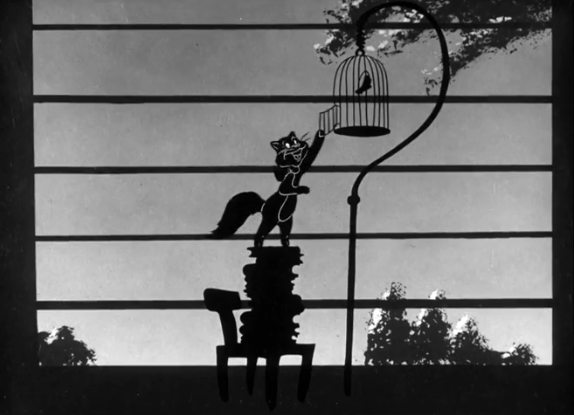
Puss n' Booty
Directed by Frank Tashlin
Rudolph the cat's owner has lost five canaries this month (and Rudolph is hiding the fact that he ate Dickie Bird, and presumably the others too). She decides to get another new canary, and Rudolph is immediately after the bird. But Petey the canary proves a bigger challenge for the cat. WB's second cat and canary cartoon is a very entertaining one, with great gags and some beautiful visuals especially in the night scenes. Some of the scenes with Petey even remind me slightly of Clampett's Tweety. And that ending is truly something! This was the very last Looney Tunes cartoon made in black and white. The Looney Tunes and the Merrie Melodies will now essentially be indistinguishable (next year will also see the end of certain characters being restricted to only one of the series), the only significant difference being the theme music.
9.5
The number of Looney Tunes and Merrie Melodies shorts released in 1943 was significantly smaller than in the previous few years. This was most likely influenced by the start of the Blue Ribbon reissue program, reducing the need for new shorts in the two series, but also the various additional cartoons the studio was commissioned to do.
The most notable of these was the Private Snafu series of cartoons for the Army–Navy Screen Magazine. A creation of film director Frank Capra, Snafu ("Situation Normal: All Fouled Up") gave his fellow soldiers advice in a humorous way, by showing them what not to do. Due to their audience, the cartoons had some content that wouldn't have been allowed in generally released films back then, such as mild swearing. The first eight entries in the series (which were usually around four minutes long) were released this year. No on-screen credits are included in the shorts themselves, but the directors are known. These shorts often have rhyming dialogue, and indeed, many of them were written by Dr. Seuss, who was working for the army at the time.
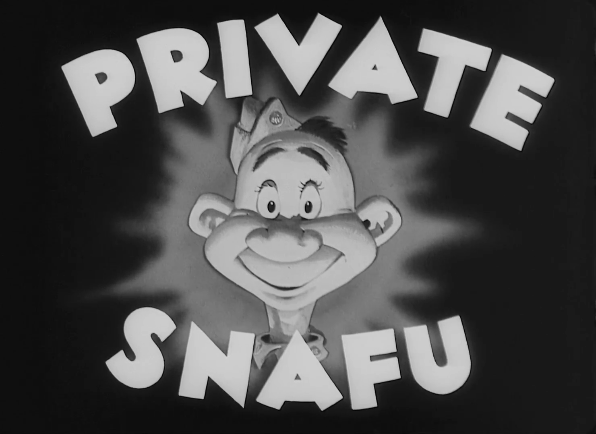
Coming!! Snafu
Directed by Charles M. Jones
An introduction to the character of Snafu. The incompetent soldier (with an eye for women) is shown failing at packing his equipment and being distracted while moving a plane. This also serves as a trailer for the series, as there's a listing of upcoming cartoons at the end. An entertaining start despite being very short (with some rather daring content included!), definitely making me look forward to what's in store.
8.5
Gripes
Directed by I. Freleng
Snafu thinks the army isn't fun enough – too much potato peeling, cleaning and getting vaccinated. But then Technical Fairy First Class (a recurring character in the series) pops up, making Snafu's wish come true – he's now promoted and gets to do everything his way. The soldiers rejoice, until the Germans attack... This is a great short – the characters have a lot of personality, and it manages to have a moral and be a lot of fun at the same time. The dialogue is entirely written in rhyme (which adds to the entertainment value) – obviously this was one of the Seuss-written shorts.
9.5
Spies
Directed by Charles M. Jones
Snafu has a military secret – he's going to Africa on a ship. But the enemy is always listening. A drunken Snafu falls for a Nazi spy who manages to get all the important details, which has disastrous consequences for the bumbling soldier. Another great short with the rhyming dialogue and an entertaining way to teach the soldiers the importance of keeping a secret. Even stronger than the previous short.
9.5
The Goldbrick
Directed by Frank Tashlin
It's raining, and Snafu doesn't want to take part in the drill. Goldie the Goldbrick (who looks quite similar to Technical Fairy First Class) appears, suggesting Snafu to come up with ways to avoid any work in the army, for example by faking illness. But predictably, it eventually backfires on him. The idea of the short is good once again, and it's well made with a song about "goldbricking". Not as good as the previous shorts, though, and the ending is quite similar in idea to the one in "Spies" but not as funny.
8
The Infantry Blues
Directed by Charles M. Jones
Snafu is in the infantry and thinks he'd have it better in the other military branches. Technical Fairy First Class grants him his wish, but the tank corps, the navy and the air corps all prove to be very challenging. A nice short, though not a spectacular one – unusually, things end quite well for our hero.
8
Fighting Tools
Directed by Robert Clampett
The Daily Sentinel hypes that U.S. fighting tools are "unbeatable if given the proper care". When Snafu meets a Nazi soldier and has to fight him, he finds out the importance of the "if". With the chase sequences, this might be the closest to the typical Looney Tune out of the Snafu shorts so far. Clampett's wild pacing is here, as is another use of the Katharine Hepburn impersonation (this time by a duck)! One of the strongest Snafus.
9
The Home Front
Directed by Frank Tashlin
It's cold, and Snafu is complaining about how easy the people at home have it. Technical Fairy First Class makes a magic TV appear, showing that Snafu's parents, grandpa and his girlfriend Sally Lou are all working hard to help with the defense effort. In addition to the nice theme of the short, there are many funny gags (including the usual cultural references) in this one.
9
Rumors
Directed by I. Freleng
After a fellow soldier makes an offhand remark about it being "nice weather for a bombing", Snafu tells a third soldier that they're in for a bombing. Rumors start spreading around the camp, as soldiers keep telling each other their misinterpretations. Soon the rumors manifest themselves as strange creatures flying around, telling even more lies and chasing Snafu. Another important lesson told in a humorous and even surreal way. One of Freleng's strangest cartoons, and the weirdest so far in the Snafu series!
9
The Schlesinger studio also made a rationing-themed short for the U.S. government. The short was directed by Chuck Jones, though he wasn't credited.
Point Rationing of Foods
An unusual WB cartoon in that it's entirely informative rather than entertaining. The six-minute short goes through the subject in detail, explaining both the reasons for rationing food products and how the point rationing system works. For the most part, the short uses still drawings or very simple animation, though there are some nice fully animated sequences where Jones' style can be seen quite clearly. It's quite hard to evaluate a short like this eighty years later, as it's not something you'd watch for entertainment, it's essentially only interesting today for historical reasons. But it does a good job explaining the concept in a way anyone can understand, and I'm sure most people would have preferred watching this to reading a boring brochure about the subject!
7.5
And that's still not all, folks – the studio (with Freleng directing without credit) also made animated sequences for a live-action film made by Andrew Stone Productions.
Hi Diddle Diddle
At the start of the film, two lovebirds are seen cuddling until one of them flies off with another bird. At the end, the characters on a singer's wallpaper (her inspiration Wagner, his family and their dogs) are annoyed with the film characters' awful singing and all leave. Compared to the quality the studio was producing at this point, this clip isn't that spectacular. The reactions are somewhat amusing, and I like the combination of animation and live-action (parts of the wallpaper sequence being shown behind the actors), though.
7
1943 was an interesting year with the increased focus on war-themed cartoons, not only in the commissioned shorts but even the Looney Tunes and Merrie Melodies themselves. For the most part, these efforts ranged from good to amazing, even if there were occasional misses like the woeful "Tokio Jokio". The cartoons not related to the war were also strong ones, especially the Bugs cartoons, and the pre-Bugs characters like Porky and even Sniffles got to appear in great, energetic shorts. The Private Snafu series is also off to a good start, and all of this will continue in 1944.
-
 4
4
-
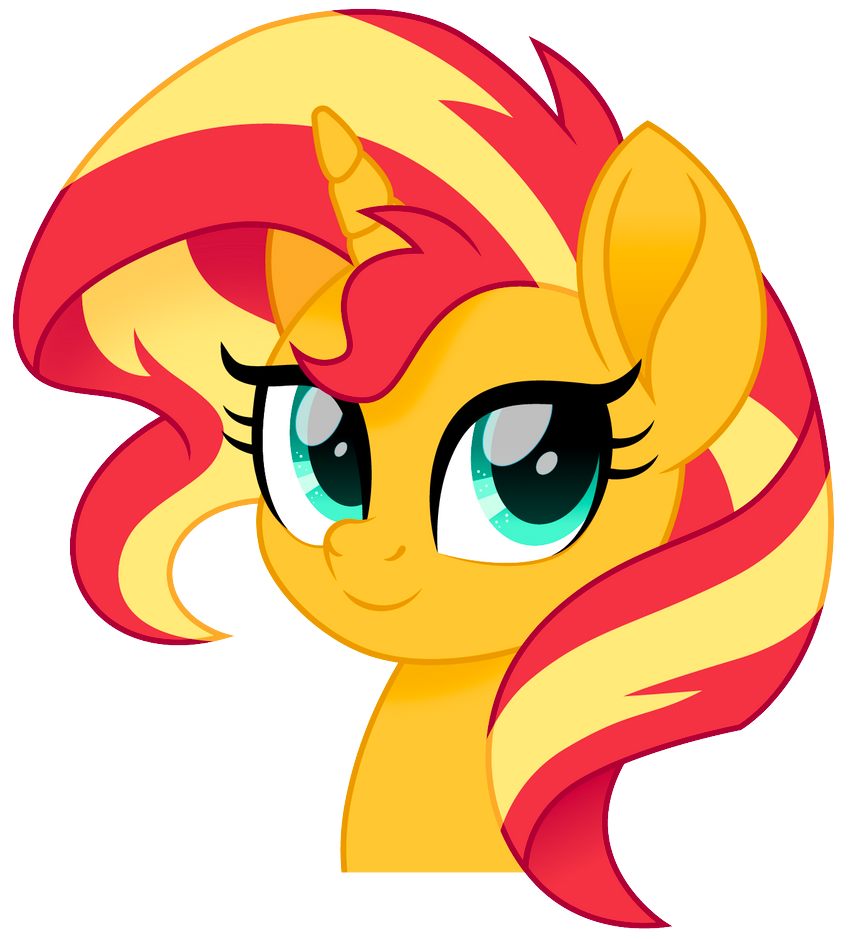 1
1



7 Comments
Recommended Comments
Create an account or sign in to comment
You need to be a member in order to leave a comment
Create an account
Sign up for a new account in our community. It's easy!
Join the herd!Sign in
Already have an account? Sign in here.
Sign In Now